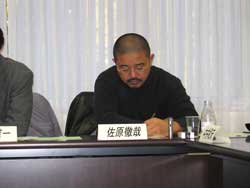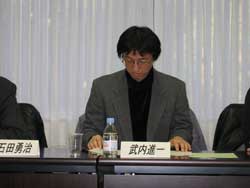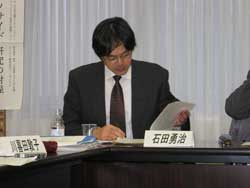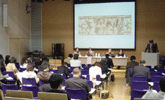Symposium:ügThe Scope of Genocide Researchüh
Schedule
üEDecember 13 th , 2003 (Saturday) 14:00-17:00
üEHeld at: Conference Rooms 3 and 4, / 3 rd Floor, Administration Building , University of Tokyo , Komaba Campus.
Programm
ü×Introductory comments: Prof. Kazuo Nakai ( University of Tokyo )
ü×Chair: Dr. Atsuko Kawakita ( University of Tokyo )
üĪReportć@:
Prof. Tetsuya Sahara ( Meiji University )
ü@ü@ü@ü@ü@ü@ü@ü@
ügEthnic cleansing in world historyüh
üĪReportćA: Shin'ichi Takeuchi ( Institute of Developing Economies )
ü@ü@ü@ü@ü@ü@ü@ü@
ügIssues raised by genocide in Rwanda üh
üĪReportćB: Prof. Yuji Ishida ( University of Tokyo )
ü@ü@ü@ü@ü@ü@ü@ü@
ügGenocide - its definition and the scope of research: concerning the broad sense of genocideüh
üĪExplanation of the project outline: Yuji Ishida
üĪReportć@:
ügEthnic cleansing in world historyüh
ü@Prof. Tetsuya Sahara ( Meiji University )
The central objective of this report is to catalogue the arguments concerning the phenomena known as genocide and ethnic cleansing, and to propose a guiding principle for a consistent understanding of the relationship between these two concepts.
Leaving the question of the definition of genocide to Professor Ishida's paper, I would like to begin by establishing the definition of the term ügethnic cleansingüh. The term ügethnic cleansingüh first appeared during the Bosnian Civil War of 1992 ~ 1995, and began to be used by journalists to refer to all of the atrocities committed during this conflict. However, it gradually came to be understood as a certain category of crimes against humanity outside the context of the Yugoslavian Civil Wars, and is now applied to similar phenomena in a variety of locations and time periods.
One method of the generalization of the term ügethnic cleansingüh has been to see it as a deliberate, calculated and organized political policy undertaken by a given autonomous authority. I would like to refer to this as the ügnarrow senseüh of the term. Representative of this position is the stipulation set forth in the report published in April 1994 by the Special Committee appointed by the Secretary-General of the United Nations to investigate ügGross Violations of the Geneva Convention and Other International Law in the Former Yugoslaviaüh. In this report, ügethnic cleansingüh is defined thus:
ügEthnic cleansingüh is a purposeful policy designed by one ethnic group or religious group to remove by violent or terror-inspiring means the civilian population of another ethnic or religious group from certain geographical areas. To a large extent, it is carried out in the name of misguided nationalism, historic grievances and a powerful driving sense of revenge.
However, such a limited position leads to the possibility of many of the issues associated with ethnic cleansing becoming abstracted. The massacres which occurred in the Bosnian Civil War, which may be considered a typical case of ethnic cleansing, were not only a systematic act propagated by a given autonomous authority, but also involved the massacre, expulsion of and pillage from ordinary people from within local or neighbouring communities, and it is in fact this which is the peculiar characteristic of ethnic cleansing. In other words, ethnic cleansing does not necessarily need the support of a government or nationalist political force, but has a ügpogromaticüh element whereby the people act of their own accord. Further, ethnic cleansing is not a particular product of an ethnocentric philosophy held by the Serbian people, who have been chiefly held responsible for such acts in this conflict. As demonstrated by examples of ethnic cleansing of the Serbs at the hands of the Albanians in Kosovo or that of the Serbs at the hands of the Croatians, ethnic cleansing need not be a unilateral act of persecution and slaughter, but rather a bilateral phenomenon in which one party can simultaneously be both victim and oppressor. In fact, one could say that ethnic cleansing shares an affinity with generic nationalism, and has even been a factor in the establishment of modern states. It is also possible to appreciate this association between nationalism and ethnic cleansing from the fact that ethnic cleansing has been employed as one means of strengthening the nation state. It has been claimed that such phenomena as the population exchanges between Greece and Turkey in 1922, the expulsion of Germans from various eastern European countries between 1946 and 1948, and the ügprocess of ethnic restorationüh in Bulgaria in the early 1980s should be taken as constituting a form of ethnic cleansing. From this, it can be deduced that ethnic cleansing is an act founded upon nationalist principles which provide the foundation for a given group defined in terms of its ethnicity to claim national hegemony, exercising its dominance over and expelling from the actual or residual state territories those from outside the dominant race, in order to establish, strengthen, maintain and expand the state.
So, how is ethnic cleansing, defined in these terms, related to the question of genocide? Until now, three arguments have been put forth concerning this matter. The first sees ethnic cleansing as one form of genocide. Those who adopt this view invoke the Genocide Convention, which states that ügdeliberately inflicting on [any national, ethnical, racial or religious] group conditions of life calculated to bring about its physical destruction in whole or in partüh is considered genocide, and take the stance that under these rules this amounts to removing ügby violent or terror-inspiring means the civilian population of another ethnic or religious group from certain geographical areasüh. However, this position, as well as involving the technical problem of the burden of proving intent to exterminate the expelled group on the behalf of the aggressors, also entails the problem of tolerating such instances of ethnic cleansing as the population exchanges of Greece and Turkey, and the post-Potsdam Declaration expulsion of Germans, as being within the discretion of a sovereign state.
The second position asserts that ethnic cleansing is entirely unrelated to genocide. Those who adopt this stance consider genocide to be peculiar and exceptional instances such as the Holocaust/Shoah, in which the aim was the extermination of the Jewish people; while ethnic cleansing is a general phenomenon which can potentially occur anywhere given the necessary conditions. The problems with this argument are the implied uniqueness of the Holocaust and the vagueness of defining the qualitative difference between ügeliminationüh and ügexterminationüh.
The third position argues that genocide is a particular form of ethnic cleansing. This argument claims that extermination is a linear extension of the act of expulsion from a fixed region; in other words, ethnic cleansing takes on the form of genocide when expulsion becomes problematic or when no external area of land has been appropriated for the reception of those expelled. This argument reflects upon the debate over whether the Holocaust was the ultimate aim if the Nazis, or whether it was an option chosen given the situation of total conflict.
Leaving aside for a moment the question of which of the above three arguments should be adopted, I would like to note some possibilities which have not been considered by these arguments. The three arguments outlined above are all one-dimensional, perceiving genocide and ethnic cleansing either as one being a subset of the other, or as being completely unrelated. However, it also seems possible to consider that the two terms might overlap at the same time as possessing an aspect in which they are unrelated. In other words, while ethnic cleansing shares the element of extermination which is the peculiar quality of genocide, the lower level of violence entailed by such acts as expulsion and exile is a far more significant factor. At the same time, while genocide can be seen as an act of violence which emerges as a linear extension of nationalism and exclusivism, one cannot ignore the fact that it has only become possible as a result of the appearance of weapons of mass destruction and devices for mass slaughter which have accompanied scientific progress. In the case of ethnic cleansing, problematic cases include population exchange conducted with the approval of a sovereign state or the international community; while in the case of genocide such examples as the use of nuclear weapons and poisonous gases leave room for investigation.
Judgement will be reserved as to which of these four arguments is most desirable, but it is clear that when considering ethnic cleansing as a part of comparative genocide studies, these arguments should be borne in mind. Doing so will not only increase the conceptual validity of the two terms, but also contribute to moves to reevaluate violence and power, and in particular national authority, in modern society.
üĪReportćA: ügIssues raised by genocide in Rwanda üh
Shin'ichi Takeuchi
ü@
( Institute of Developing Economies )
This report seeks to organize the arguments raised concerning the genocide which took place in Rwanda during the 1990s. Sparked by the assassination of President Habyarimana in a plane crash on April 6 th , 1994 , 500,000 to 800,000 people were massacred in a period of less than three months. This number represented approximately one tenth of the total national population of the time, and it is said that as many as three quarters of the Tutsi ethnic group, who were particularly victimized, were killed. The Rwandan population can be divided into three distinct ethnic groups: the Hutu, comprising over eighty percent of the population, the Tutsi, comprising approximately one tenth of the population, and the Twa, who make up around one percent of the population. However, all three groups share a common language and reside in the same areas, and the former distinctions which existed in terms of vocations have all but disappeared today. Intermarriage between ethnic groups is also commonly observed.
This genocide drew worldwide attention, and along with concerns about the prevailing political powers in Rwanda , has fuelled a number of arguments until this day. An investigation of these various arguments leads to the identification of five distinct issues of debate, which in turn contain many problems requiring elucidation.
First, there is the debate concerning the cause of this genocide. Here, the issue of the changing face of ethnicity under colonial rule looms large. Under colonial rule the relationship between the Tutsi and the Hutu underwent a dramatic metamorphosis, with individuals' ethnic identification becoming re-apparent and the distinction between groups more rigid. This fermented animosity and hostility between groups defined as ethnic units, so that by the end of the colonial era the advent of political power struggles between one party dominated by the Tutsi and another dominated by the Hutu led to violent conflict between the two ethnic groups. At this time, due to the backing of the colonial authorities, the Hutu-dominated party seized control of the newly independent state, and a large number of Tutsis fled the country as refugees. The invasion of the country from Uganda by the second generation of these refugees brought about the civil war, which in turn led to genocide four years later.
The second point of debate concerns the methods used in the massacres. It is generally understood that in the case of genocide in Rwanda , the general public participated, with peasants committing acts of slaughter armed with hatchets. However, a reexamination of the situation based upon published materials and interviews indicates that while there were instances in which the general populace was involved in the killings, for the most part the massacre was conducted by the military and the police force using modern weaponry. Further, the militia groups which played such a significant role in the carrying out of the massacres originated from the single-party era. The methods used in the massacres are therefore intimately related to the structure of the post-colonialist state.
The third issue concerns the involvement of the international community. The genocide in Rwanda occurred as one outcome of the civil war, but the international community was involved throughout, influencing the political situation in a variety of ways, from the signing of a peace accord, to the deployment of Peace Keeping Organizations (and their withdrawal when genocide occurred), to the establishment of the International Criminal Tribunal for Rwanda. The elucidation and evaluation of the role of the international community is an extremely important area of debate.
Fourth, there is the issue of the repercussions the genocide in Rwanda had upon the surrounding countries and on the international community. The mass exodus of refugees which took place following the genocide in turn brought about a civil war in the neighbouring Democratic Republic of the Congo (formerly Zaire), bringing down the Mbutu rule which had continued for more than thirty years. Furthermore, the fact that effective intervention to stop the genocide was not achieved led to a prevailing sense of a need for atonement within the international community, which engendered an environment sympathetic to the RPF (Rwandan Patriotic Front), established after the massacres. It may be said that this in turn led to the international community turning a blind eye to the war crimes later committed by the RPF.
The fifth and final issue is how to rebuild a nation and a society after such an unprecedented humanitarian tragedy as genocide. In the case of the genocide in Rwanda , reconciliation has been striven for through the conduction of legal proceedings at a number of different levels, from the International Criminal Tribunal for Rwanda , to the Belgian Criminal Courts, the Rwandan Criminal Courts, and even the ügGacacaüh, hearings which take place in rural villages. However, even now the war crimes committed by the RPF have yet to be tried, and whether such legal proceedings can make reconciliation possible remains unclear.
As shown above, an identification of the key debates concerning the Rwandan massacres demonstrates that they straddle several academic disciplines, from history to international relations, politics to law. It may be claimed that the issues related to genocide are multi-disciplinary in nature, and that this is a valuable research area that may serve as a bridge between academic areas.
üĪReportćB: ügGenocide - its definition and the scope of research: concerning the broad sense of genocideüh
Prof. Yuji Ishida ( University of Tokyo )
My report relates to the definition of genocide and the scope of research entailed by the term genocide studies. In light of what was made apparent in session one, I believe it is possible to deal succinctly with the issue of the definition and the scope and issues for research in this report.
As is well-known, the word üggenocideüh is made up of the Greek word üggenosüh, meaning ügraceüh or ügpeopleüh, and the Latin ügcideüh, ügto killüh. Raphael Lemkin, a Polish expert on international law of Jewish origin is credited as having coined the word, but it is now an established concept within international law, given a clear definition in the Genocide Convention adopted by the General Assembly of the United Nations in 1948 and in the Rome Statute of the International Criminal Court (hereafter ICC) of 1998.
In this research project, we will prioritize this definition. However, it would be undesirable to overly privilege this definition to the extent that our field of research is narrowed. Which is to say, that this definition is a very narrow one - obviously so, since it is a criminal legal concept - and can seem very restricting to us researchers, who are neither judges nor public prosecutors, in that when we come to think about events in terms of the relationships between their historical backgrounds, their processes and their outcomes, and link these to various causes, we may find that it becomes difficult to develop an argument under this definition. I will touch on this point in a subsequent paragraph, but firstly, I would like, in this research project, to explore from an empirical research point of view the issue of whether the concept of genocide as defined by international law appropriately accounts for actual historical realities.
ć@ The distinction between genocide and ügcrimes against humanityüh
As defined by the Rome Statute of the ICC finally published in 2002, genocide ranks alongside ügcrimes against humanityüh, ügwar crimesüh, ügcrimes of aggressionüh as one of the major criminal categories in international law. (Refer to distributed material.) In fact, the Rome Statute definition of genocide followed the line established in the 1948 ügGenocide Conventionüh. From this statement alone, one might assume that the concept had not developed in that period of time, but it is important to note that in the Rome Statute, in exchange for not altering the definition of genocide, the concept of ügcrimes against humanityüh which had hereto been insufficiently defined in international law was clarified, enabling genocide to be clearly distinguished from the category of crimes containing ügcrimes against humanityüh, and granted a new and unique position. The definition of genocide in Article 6 of the Rome Statute of the ICC is as follows.
For the purpose of this Statute, "genocide" means any of the following acts committed with intent to destroy, in whole or in part, a national, ethnical, racial or religious group, as such:
(a) Killing members of the group;
(b) Causing serious bodily or mental harm to members of the group;
(c) Deliberately inflicting on the group conditions of life calculated to bring about its physical destruction in whole or in part;
(d) Imposing measures intended to prevent births within the group;
(e) Forcibly transferring children of the group to another group.
When one compares this to the Rome Statute's new definition of ügcrimes against humanityüh, one appreciates many points they have in common in terms of punishable acts. So, what are the differences between these terms? The first difference is that while the victims of genocide are defined as belonging to one of four types of group (national, ethnical, racial or religious), the victims of ügcrimes against humanityüh are ordinary citizens, civilians. The second difference is that while genocide requires ügintent to destroy, in whole or in partüh one of the four types of group mentioned above, there is no such stipulation for ügcrimes against humanityüh. To summarize, while genocide appears to double up with ügcrimes against humanityüh on the surface, in fact it differs from the latter in that its victims must be members of one of four fixed categories of groups, and must aim at the destruction ügin whole or in partüh of the group.
ćA Concerning punishable acts
Let us now examine each of the above-mentioned punishable acts (a) to (e) in concrete terms.
(a) ügKilling members of the groupüh requires no explanation.
(b) ügCausing serious bodily or mental harm to members of the groupüh includes torture, rape and sexual violence, enforced drug usage, amputation and also the mental trauma inflicted upon group members by such acts.
(c) ügDeliberately inflicting on the group conditions of life calculated to bring about its physical destruction in whole or in partüh includes intentionally depriving the group of resources such as drinking water, clothing, food, housing and medical services, which are essential to its physical survival. Other acts which also fall into the category of the deprivation of the opportunity for maintaining quality of life are the confiscation of harvests, the blocking of food supply lines, incarceration, forced migration and exile into the desert.
(d) ügImposing measures intended to prevent births within the groupüh includes such acts as forced castration or sterilization, forced abortion, prohibition of marriage and male-female segregation to prevent reproduction.
(e) ügForcibly transferring children of the group to another groupüh includes not only migration forced by direct violence, but also that forced by fear and the psychological pressure of the threat of violence.
Viewed in this manner, punishable acts of genocide are not merely restricted to killing or creating conditions leading to the death of members of the group, but can also form part of a political plan designed to destroy a group in whole or in part by inflicting physical or psychological damage, preventing reproduction, enforced child migration and the like.
I would like to add five further points:
1. Planning or abetting genocide is a crime, regardless of whether such acts occur before the actual genocide. Further, incitement or support of genocide is likewise a criminal offence.
2. The determination of whether or not an act constitutes genocide depends upon the existence or otherwise of ügintent to destroy, in whole or in part, a üc groupüh. To prove this intent, statements (words) and commands (documents) may be used as direct evidence, but intent may also be inferred from the systematic patterns of behaviour of the perpetrators.
3. An act will be considered genocide if it is conducted with intent to destroy in whole or in part any one of the four above-mentioned categories of groups, regardless of the political, economic, cultural, social or military motivation behind it or aim in mind; be that aim the stabilization of authority, the suppression of opposition factions, the exploitation of human or material resources, land development, cultural unification, maintenance of territorial integrity, the securing of public order or the conduction of war. Indeed cases in which genocide is carried out for its own sake are rare; it is almost always carried out with some other motivation or towards some other goal. When one decides whether or not an act constitutes genocide, its motive is never in question.
4. As indicated by the phrase ügthe destruction in whole or in part of a üc groupüh, it is not necessary to destroy all of a group in order to constitute genocide; the destruction of part only ? for example, the killing of a political or religious leadership or of intellectuals, or of the residents of a fixed region ? is sufficient. Even if only one person is killed, if this killing is part of a conscious plan for the destruction of a group, then the killer becomes a perpetrator of genocide.
5. There is no set definition of the perpetrator. Nation states, organizations, groups or even individuals can be perpetrators of genocide.
In the introduction, I noted the narrowness of the concept of genocide in international law, but there may be readers who feel that it is in fact quite broad from the explanation given up to this point. Therefore, I would now like to explain why I claimed it was narrow, by considering the problem of genocide in international law. Here, I would like to focus on two aspects: the groups subjected to genocide and punishable acts, and propose a ügbroad definition of the concept of genocideüh.
ćB The broad sense of genocide - the arbitrariness of decisions made by the perpetrators
First, let us consider the victimized groups in genocide.
From the time of the establishment of the Genocide Convention to the present day, a major point of dissent has been whether or not to include political groups in the category of victims of genocide; that is, groups who have been harmed because of their political creed or political party affiliation. These groups were included in this category in the draft stage of the Genocide Convention drawn up after World War Two, but were eventually removed at the objection of the Soviet Union. Neither was this omission corrected in the Rome Statute of the ICC. In my own opinion, while the perpetrators of genocide appear at first glance to be destroying a given group of human beings, in fact they are often ügcreatingüh the group to be destroyed themselves. For example, in the case of Nazi Germany's Holocaust, it appears as if Jewish people were eradicated simply because they were Jewish, but in fact the Jews to be killed were determined by the Nazis' arbitrary definition. (Such terms as ügpure Jewsüh and ügone quarter Jewsüh eloquently speak for this position.) Further, under the Nazi regime, the category of üganti-social elementsüh was created, and groups which were defined as belonging to this category were eliminated. In other words, there are cases in which prior to the act of genocide, the perpetrators arbitrarily define the object of genocide.
One legal system which recognizes this arbitrary selection on the part of the perpetrators is the new French Penal Code, established in 1994. At present, most of the 135 countries which have ratified the Genocide Convention have made it part of their national law, but among these the new French Penal Code is groundbreaking. ( Japan has not even signed, let alone ratified the Convention.) I would like to quote Article 211-1 from the French Penal Code.
[1] Genocide is committing or causing to be committed, in the execution of a prearranged plan leading to the total or partial destruction of a national, ethnic, racial or religious group, or of a group established by reference to by other arbitrary criteria, one of the following acts against members of the group:
1. willful infringement on life;
2. serious infringement on physical or mental integrity;
3. infliction of conditions of existence likely to involve the total or partial destruction of the group;
4. measures aimed at blocking births;
5. forced transfer of children.
[2] Genocide is punishable by imprisonment for life.
I would like to utilize this new French Penal Code, which incorporates this element of arbitrariness on the part of the perpetrator in genocide, as the fundamental premise of this research. Based upon this arbitrary nature of the decision-making of the perpetrators, it becomes possible to posit genocide targeted against those outside the four categories of group mentioned above. For example, as well as political groups, social classes such as the ügkulaküh which were victimized under Stalin's regime, the üganti-social elementsüh of the Nazi regime (repeat offenders, homosexuals, labour evaders), and ügresistant elementsüh and ügpartisansüh in times of international and civil war, will all be subjects for research.
ćC The broad definition of genocide - ügcultural genocideüh
In the process of the drawing up of the Genocide Convention, an objection was raised to limiting the definition of genocide to the five punishable offences listed above as (a) - (e) (these are the same as in the French Penal Code), and in a draft of the Genocide Convention, the following proposal was made with regard to punishable offences: that alongside ügphysical genocideüh (homicide, mass murder, the imposition of lifestyle conditions designed to make existence impossible, biological experimentation on the human body), ügbiological genocideüh (enforced castration/ sterilization, enforced abortion, segregation of the sexes, prohibition of marriage), ügcultural genocideüh should be recognized. Ultimately, the first two types were reorganized and ratified as the five punishable acts (a) - (e), but ügcultural genocideüh was not adopted. This was because countries involved feared that their conduct during colonial rule would come in question.
Incidentally, what did those who proposed the inclusion of ügcultural genocideüh have in mind? They stipulated that forced migration of children, exile of the intelligentsia, the prohibition of native languages, the systematic destruction of religious and secular publications in native languages, the destruction of historical or religious monuments and the destruction of cultural properties and historical texts, would constitute ügcultural genocideüh. ügCultural genocideüh was also excluded in the Rome Statute of the ICC, but I would like to include it as a form of genocide for the purposes of this project.
üØ In this research project, we would like to position the definition of genocide recognized by international law as the ügnarrow sense of genocideüh, and position ügcultural genocideüh, unrecognized by international law, and cases in which the perpetrators arbitrarily establish the groups to be victimized as the ügbroad sense of genocideüh, and study both types. (See chart 1.) In this way this research aims to broaden the scope of genocide studies, and at the same time shed some light upon the boundary lines between genocide and other crimes under international law, to reveal the various connections between genocide and other phenomena.
ćD War and genocide
As an example of a boundary line research topic, ügwar and genocideüh is one possibility. Until now, there has been a tendency to view war and genocide as separate entities. For example, for a long time in Holocaust research, the relationship between the genocide of the Jews and the war was rejected, with the former seen as an unrelated independent crime. Indeed, to separate genocide from war was in itself one of the aims of those who established the Genocide Convention. In research of recent years, however, the inseparable relationship between World War Two and the Holocaust has become clear, and the actions on the Eastern Front against the Soviet Union have come to be seen in terms of genocide. The arbitrary designation of a group to be partially or fully destroyed with the aim of assisting progression of the war has been frequently seen in World War Two Europe and Asia, and in the Vietnam and Gulf Wars.
Chart 1
Act |
|||
The five punishable acts
(physical/ biological genocide) |
Cultural genocide |
||
Victim |
The four categories of group (national, ethnical, racial, religious)
|
Narrow definition of genocide
|
Broad definition of genocide |
Groups arbitrarily determined by the perpetrators |
Broad definition of genocide |
Broad definition of genocide |
|



